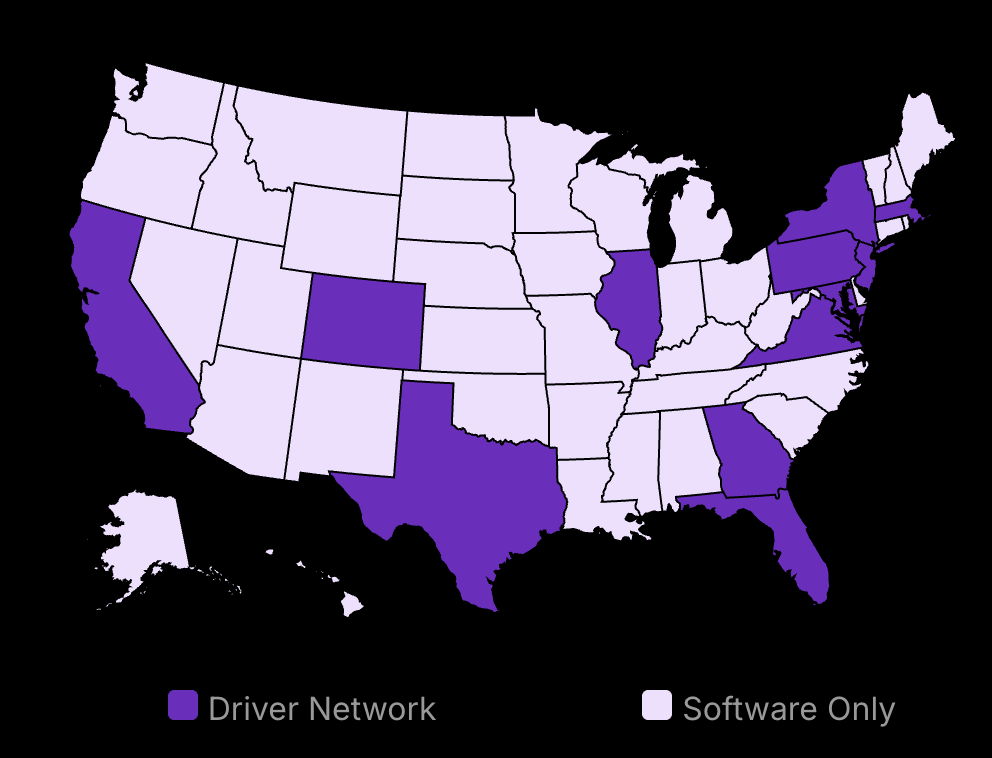Want to start a profitable online business without holding inventory? Dropshipping could be your answer.
In 2024, e-commerce is still booming, and dropshipping remains a viable way to earn income online. But with increased competition, you need a strategic approach to stand out and attract customers.
How to make money dropshipping? This guide will walk you through the essential steps to launch and scale a successful dropshipping app business in 2024, from choosing a niche to optimizing your store for conversions.
Ready to dive in? Let’s get started.

Save 80% of delivery management time
We handle everything:
- Dedicated operations manager
- Real-time tracking dashboard
- Automated customer notifications
- Urgent issue resolution
Choosing a Profitable Niche: The Key to Dropshipping Success
Researching market demand and competition
Identifying a profitable niche is crucial for dropshipping success. Start by using tools like Google Trends and keyword research to uncover popular product categories with consistent demand. Look for niches that show steady or increasing search volume over time, indicating a stable market. Discover the essentials of crafting a business plan for your dropshipping venture to ensure you target the right niche and maximize profitability.
Next, analyze the competition within potential niches. While some competition is healthy, avoiding oversaturated markets is essential for profitability. Assess the number of sellers, their pricing strategies, and the quality of their offerings. Aim for niches with room for differentiation and competitive pricing.
Market Size:
The global dropshipping market was valued at $428.3 billion in 2024 and is expected to reach $722.6 billion by 2033.
Niche products with high demand and low competition
Consider focusing on niche products that cater to specific customer needs or preferences. These products often have high demand but lower competition compared to mainstream items that sell products. Examples include eco-friendly alternatives, specialized fitness equipment, or unique hobby supplies. For instance, the demand for eco-friendly products has been increasing, with the global market expected to reach $150.1 billion by 2025.
Identifying your target audience
Understanding your target audience is key to selecting a profitable niche and tailoring your marketing efforts. Define your ideal customer’s demographics, such as age, gender, income level, and location. Identify their interests, hobbies, and pain points that your products can address.
Create buyer personas to represent your target audience segments. These fictional profiles help you visualize and understand your customers’ needs, preferences, and buying behaviors. Use this information to guide your product selection and marketing strategies.
Aligning your niche with personal interests and expertise
When choosing a niche, consider your own interests and areas of expertise. Passion for your products can drive motivation and help you create engaging content. Familiarity with the niche also allows you to provide valuable insights and customer support, enhancing the shopping experience.
However, balance personal interests with market demand and profitability. Validate your chosen niche’s potential through research and data analysis before committing to it.
Evaluating the profitability of a dropshipping niche
To determine if a niche is genuinely profitable, consider factors such as sales strategy, product pricing, supplier costs, and shipping expenses. Aim for products with healthy profit margins that allow room for marketing and operational costs.
Research the average order value (AOV) within your niche. Higher AOVs often lead to better profitability, as they can offset fixed costs like advertising and platform fees. However, ensure the pricing remains competitive and attractive to your target audience.
Dropshipping income potential: How to make money dropshipping?
Dropshipping can be a profitable venture, but income potential varies greatly depending on factors like niche selection, marketing strategies, and operational efficiency. While some successful dropshippers earn five to six figures per month, it’s essential to have realistic expectations, especially as a beginner.
Competitive Landscape:
Only 10% of dropshippers achieve success in their first year.
The average dropshipper’s income varies widely, with many earning a few hundred to a few thousand dollars per month. Achieving higher income levels, such as $10,000 per month, requires significant effort, strategic planning, and continuous optimization. According to a survey by Oberlo, 22.5% of dropshippers earn between $1,000 and $5,000 per month, while 10.3% earn more than $10,000 per month.
$50K+ Dropshipping Stores:
1.5% of dropshipping stores achieve more than $50K in monthly revenue.
Adapting to market trends and consumer preferences
As consumer preferences and market trends evolve, regularly reassess your chosen niche’s profitability. Stay informed about emerging trends, new products, and shifts in customer behavior. Be prepared to adapt your product offerings and marketing strategies accordingly.
Continuously monitor your sales data, customer feedback, and competitor activities to identify opportunities for improvement or expansion. Embracing change and staying agile can help you maintain a profitable dropshipping low risk business model in the long run.
Supplier Reliability:
84% of ecommerce retailers find that establishing a relationship with a reliable dropship supplier is crucial to success.
Finding Reliable Dropshipping Suppliers: Building a Strong Foundation
Sourcing products from reputable suppliers
When starting a dropshipping business, finding reliable suppliers is one of the most critical steps. Reputable best dropshipping suppliers will ensure that your customers receive high-quality products in a timely manner, which is essential for building a strong reputation and generating repeat business.
To find reliable suppliers, start by researching potential options on popular platforms like AliExpress, SaleHoo, and Worldwide Brands. These platforms offer a wide range of products from various suppliers, making it easier to find items that fit your niche. When evaluating suppliers, pay close attention to their reviews and ratings. Look for suppliers with consistently positive feedback from other dropshippers, as this indicates a track record of reliability and quality. By carefully selecting your dropshipping partners, you can significantly improve your e-commerce venture’s success and customer satisfaction.
Once you’ve identified potential suppliers, reach out to them to establish a working relationship. Ask questions about their products, shipping times, and return policies to ensure they align with your business needs. Building a strong rapport with your suppliers can lead to better communication, faster problem resolution, and even exclusive deals or discounts in the future.
Negotiating prices and terms
Negotiating favorable prices and terms with your suppliers is another key aspect of building a strong foundation for your dropshipping business. By securing competitive pricing, you can maximize your profit margins while still offering attractive prices to your customers.
When negotiating with suppliers, discuss minimum order quantities (MOQs) and see if they’re willing to lower them for a long-term partnership. Lower MOQs can help you test products without committing to large inventory purchases. Additionally, inquire about shipping times and costs, as these factors directly impact your customers’ experience and your bottom line.
It’s also crucial to discuss return policies and how suppliers handle defective or damaged products. Having a clear understanding of these policies will help you create a seamless return process for your customers and minimize potential losses.
Payment terms and long-term partnerships
As you build relationships with your suppliers, consider negotiating favorable payment terms. Some suppliers may offer discounts for early payments or allow you to pay in installments, which can help manage your cash flow more effectively. Long-term partnerships with suppliers can also lead to better pricing, priority shipping, and access to new products before your competitors. According to TradeGecko, building long-term relationships with multiple suppliers also can result in benefits such as improved communication, increased trust, and better pricing. Similarly, Unleashed Software highlights the importance of strong supplier relationships in managing inventory and improving supply chain efficiency.
Verifying supplier reliability and product quality
Before committing to a supplier, it’s essential to verify their reliability and the quality of their products. One way to do this is by ordering product samples. Most suppliers offer samples at a discounted price or even for free, allowing you to assess the product’s quality, packaging, and shipping time firsthand.
When you receive the samples, carefully inspect them for any defects or inconsistencies. If the products meet your expectations, you can confidently move forward with the supplier. If not, it’s best to continue your search for a more reliable partner.
Another way to verify supplier reliability is by conducting thorough research on their business. Look for information about their factory, production processes, and certifications. Reputable suppliers often provide detailed information about their operations and are transparent about their practices.
Monitoring supplier performance
Once you’ve established relationships with reliable suppliers, it’s crucial to monitor their performance consistently. Keep track of key metrics such as shipping times, product quality, and customer feedback. If you notice any issues or inconsistencies, address them with your suppliers promptly to maintain a smooth operation and high customer satisfaction levels.
By continuously monitoring and working with your suppliers, you can build a strong foundation for your dropshipping and other business together, ensuring long-term success and growth.
Marketing Your Dropshipping Store: Driving Traffic and Sales
Implement effective SEO strategies, targeted advertising campaigns, and social media marketing to drive traffic to your store
Build a strong brand presence and partner with influencers to increase visibility and credibility
Monitor and optimize your marketing efforts based on performance data to maximize ROI
Implementing effective SEO strategies for your online store
Search engine optimization (SEO) is crucial for driving organic traffic to your dropshipping store. To optimize your ecommerce store’s content and product descriptions for relevant keywords, conduct thorough keyword research using tools like Google Keyword Planner, SEMrush, or Ahrefs. Identify long-tail keywords with lower competition and higher search intent, and incorporate them naturally into your content.
Building high-quality backlinks is another essential aspect of SEO. Reach out to relevant websites, blogs, and online publications in your niche, and offer to contribute valuable content in exchange for a backlink. Guest posting, broken link building, and creating shareable infographics are effective strategies for acquiring quality backlinks.
Leveraging content marketing for SEO
Content marketing is a powerful way to attract organic traffic and establish your brand’s authority. Create informative blog posts, product guides, and tutorials that address your target audience’s pain points and provide solutions. Consistently publishing high-quality content will not only improve your search engine rankings but also foster trust and loyalty among your potential customers.
Running targeted advertising campaigns
Paid advertising allows you to reach your target audience quickly and drive targeted traffic to your store. Platforms like Google Ads and Facebook Ads offer robust targeting options, enabling you to create campaigns tailored to your ideal customer’s demographics, interests, and behaviors.
When creating ad copy and visuals, focus on highlighting your products’ unique selling points and benefits. Use compelling headlines, eye-catching images, and clear calls-to-action (CTAs) to encourage clicks and conversions. A/B test different ad variations to identify the best-performing elements and optimize your campaigns accordingly.
Monitoring and optimizing ad performance
To ensure the success of your advertising efforts, regularly monitor your campaigns’ performance data, such as click-through rates (CTR), conversion rates, and return on investment (ROI). Use this information to make data-driven decisions and optimize your campaigns for better results. Adjust your targeting, ad copy, and budget allocation based on what works best for your store.
Leveraging social media and influencer marketing
Social media platforms like Instagram, Facebook, and TikTok provide excellent opportunities to engage with your target audience and promote your dropshipping services and products. Create a strong brand presence by consistently posting valuable content, engaging with your followers, and showcasing your products in action.
Partnering with micro-influencers in your niche can be a cost-effective way to expand your reach and drive sales. Identify influencers whose audience aligns with your target market, and collaborate with them to create authentic, engaging content that promotes your products. Influencer marketing can help build trust and credibility, as their followers are more likely to purchase products recommended by someone they admire.
Running social media contests and giveaways
Running contests and giveaways on social media can be an effective way to increase brand awareness, grow your following, and encourage customer loyalty. Create a contest that requires participants to follow your account, like and share your post, and tag friends in the comments. Offer attractive prizes related to your niche, such as gift cards or popular products from your store.
Addressing Common Questions
Is $100 enough to start dropshipping?
While it’s possible to start a dropshipping business with a small budget, $100 may be challenging. You’ll need to allocate funds for setting up your store, purchasing a domain, and investing in essential marketing efforts. It’s recommended to have a slightly larger budget to give your business the best chance of success.
Is dropshipping a good idea for beginners?
Dropshipping can be a good option for beginners, as it requires less upfront investment and has lower risks compared to traditional retail models. However, it’s essential to approach dropshipping companies with realistic expectations and be prepared to invest time and effort into building your business.
Dropshipping Gains Popularity:
27% of online retailers have adopted dropshipping as their primary order fulfillment method.
How much do beginner dropshippers make?
The income of beginner dropshippers varies greatly depending on factors such as niche, marketing efforts, and product quality. While some dropshippers may earn a few hundred dollars per month, others can scale their businesses to generate thousands or even millions in revenue. Success in dropshipping requires dedication, continuous learning, and adapting to market trends.
Dropshipping Success Rate:
The success rate among top dropshippers is estimated to be 10-20%.
Optimizing Your Store for Conversions: Turning Visitors into Customers
Creating a user-friendly website design
Your dropshipping store’s design plays a crucial role in converting visitors into customers. A clean, intuitive, and mobile-responsive layout is essential to provide a seamless browsing experience. Ensure that your store loads quickly and is easy to navigate, minimizing the risk of visitors leaving due to frustration or confusion.
Incorporate trust signals throughout your website to instill confidence in potential customers. Display customer reviews prominently, as they serve as social proof and can significantly influence purchasing decisions. Adding security badges and clear return policies further demonstrates your commitment to customer satisfaction and can help alleviate any concerns visitors may have about making a purchase from your store.
Optimizing for mobile devices
With the increasing prevalence of mobile shopping, it’s crucial to ensure that your dropshipping store is fully optimized for mobile devices. Responsive design ensures that your dropshipping website automatically adapts to various screen sizes, providing a consistent and user-friendly experience across all devices.
Implementing effective product pages
Your product pages are the cornerstone of your dropshipping store’s success. Craft compelling product titles and descriptions that highlight the key features and benefits of your offerings. Use clear, concise language that resonates with your target audience and addresses their pain points or desires.
High-quality product images and videos are essential for showcasing your products in the best possible light. Provide multiple angles, close-ups, and lifestyle shots to help potential customers visualize the product in use. Consider including user-generated content, such as customer photos or videos, to add authenticity and social proof.
Ensure that your product pages include clear calls-to-action (CTAs) to guide visitors towards making a purchase. Use prominent “Add to Cart” or “Buy Now” buttons that stand out from the rest of the page. Simplify the checkout process by minimizing the number of steps required and offering various payment options to cater to different preferences.
Optimizing product descriptions for search engines
In addition to providing valuable information for potential customers, your product descriptions can also help improve your store’s search engine rankings. Incorporate relevant keywords naturally throughout your product titles and descriptions to increase visibility in search results.
Offering exceptional customer service
Providing outstanding customer service is crucial for building trust, and loyalty, and encouraging repeat business. Offer multiple contact options, such as email, phone, and live chat support, to cater to different communication preferences. Respond promptly to customer inquiries and resolve any issues in a timely and professional manner.
Implement a hassle-free returns and refunds policy to demonstrate your commitment to customer satisfaction. Clearly communicate your policy on your website and make the process as simple as possible for customers. By going above and beyond to address customer concerns and provide solutions, you can foster a positive reputation and encourage word-of-mouth referrals.
Using customer feedback to improve
Actively seek out customer feedback and use it to continuously improve your dropshipping store’s user experience and product offerings. Encourage customers to leave reviews and ratings, and regularly monitor this feedback to identify areas for improvement.
Scaling Your Dropshipping Business Model: Strategies for Growth
Expand your product range and test new niches to diversify revenue streams
Automate processes and outsource tasks to focus on high-level strategies
Leverage influencer marketing and affiliate programs to reach new audiences
Expanding your product range
As your dropshipping business grows, it’s essential to continuously do market research, and add new products to your store based on market trends and customer demand. By diversifying your product offerings, you can tap into new customer segments and increase your revenue potential.
To identify potential new products, regularly monitor social media trends, industry news, and competitor offerings. Use tools like Google Trends and Amazon Best Sellers to gauge product popularity and demand. When adding new products, start with a small test batch to assess their performance before fully committing to larger quantities.
Testing new product categories and niches
Don’t be afraid to venture into new product categories and niches that complement your existing offerings. For example, if you currently sell fitness equipment, consider expanding into nutrition supplements or workout apparel. By offering related products, you can create a more comprehensive shopping experience for your customers and encourage cross-selling.
Automating processes and outsourcing tasks
As your dropshipping business scales, it becomes increasingly important to streamline your operations and focus on high-level strategies. Implementing automation tools for tasks like order processing, inventory management, and customer communication can save you significant time and resources.
Popular automation tools for dropshipping businesses include Oberlo, Dropified, and AutoDS. These platforms can help you manage product listings, track inventory levels, and handle order fulfillment seamlessly.
Outsourcing non-core tasks
In addition to automation, outsourcing non-core tasks can free up your time to focus on growth strategies. Consider hiring freelancers or agencies to handle tasks like customer service, content creation, and graphic design. Platforms like Upwork, Fiverr, and Freelancer.com offer access to a global pool of talented professionals who can support your business needs.
By delegating these tasks, you can dedicate more energy to high-level decision-making, such as identifying new market opportunities, developing partnerships, and optimizing your marketing efforts.
Leveraging influencer marketing and affiliate programs
Influencer marketing and affiliate programs are powerful tools for reaching new audiences and driving sales. Partnering with influencers in your niche can help you tap into their engaged followings and build trust with potential customers.
To find relevant influencers, use tools like BuzzSumo, NinjaOutreach, or AspireIQ. Look for influencers whose content aligns with your brand values and target audience. Develop a clear campaign brief outlining your goals, expectations, and compensation structure before reaching out to potential partners.
Implementing an affiliate program
Creating an affiliate program can also help you expand your reach and generate more sales. By offering commissions to affiliates who promote your products, you can incentivize them to drive traffic and conversions to your store.
To set up an affiliate program, consider using platforms like ShareASale, ClickBank, or Rakuten Marketing. These platforms provide the necessary tools and tracking capabilities to manage your affiliates effectively.
Regarding the question of making $10,000 per month dropshipping, it is possible, but it requires significant effort, strategic planning, and continuous optimization. The amount you can earn depends on factors like your product niche, target market, marketing efforts, and overall business strategy.
To reach this income level, focus on identifying high-demand, profitable products and investing in targeted marketing campaigns. Continuously monitor your store’s performance and make data-driven decisions to improve your conversion rates and average order value.
For example, successful dropshippers like Irwin Dominguez, who made over $1 million in a single month, demonstrate the potential of this business model.
Frequently Asked Questions About Dropshipping
Dropshipping is a retail fulfillment method where a store sells products without keeping them in stock. When a customer places an order, the store purchases the item from a third-party supplier, who then ships the product directly to the customer. The store never handles the product itself, acting as a middleman between the supplier and the customer. Thinking about initiating a dropshipping venture? Learn the secrets to launching your business successfully, picking trustworthy suppliers, and sidestepping typical mistakes.
This business model allows entrepreneurs to start an online store without investing in inventory upfront. It reduces the financial risk associated with traditional retail businesses, as the store only purchases products when a customer has already paid for them. Dropshipping enables store owners to focus on marketing, customer service, and growing their business without worrying about inventory management and the shipping costs and logistics. Discover the steps to initiate dropshipping on Amazon and amplify your eCommerce venture with efficiency.
Dropshipping Profits:
Dropshipping stores generate 50% more profit than those relying solely on their online inventory.
How much capital do I need to start dropshipping?
While it’s possible to start a dropshipping business with a minimal investment, it’s recommended to have around $100-$500 to cover initial expenses. This capital will be used for essential costs such as website hosting, domain registration, and initial advertising. According to Shopify, the initial investment for starting a dropshipping business can range from $100 to $1,000, depending on the scope of the business and the tools used.
Is $100 enough to start dropshipping?
Starting a dropshipping business with $100 is possible, but it may be challenging. With a limited budget, you’ll need to be creative and resourceful in your approach. Consider using a free e-commerce platform like WooCommerce or Shopify’s free trial to minimize costs. You can also opt for a low-cost domain name and hosting plan to keep expenses low. Oberlo suggests that a budget of $100 can be sufficient for the initial setup, but additional funds may be needed for marketing and growth.
However, investing a bit more capital, around $200-$500, can give you a better foundation for success. These additional funds can be used for professional store design, premium apps and tools, and targeted advertising campaigns. As your business grows, you may need to reinvest profits into marketing and tools to scale effectively.
Online Sales:
Dropshipping accounts for 23% of all online sales.
Is dropshipping still profitable in 2024?
Yes, dropshipping remains a viable and profitable business model in 2024. As e-commerce continues to grow, the opportunities for successful dropshipping ventures persist. According to Nasdaq, the dropshipping model is a profitable online business model due to its low overhead costs and flexibility. However, success in dropshipping depends on several key factors:
1. Choosing the right niche: Identifying a niche market with high demand and low competition is crucial for profitability and successful business.
2. Finding reliable suppliers: Partnering with trustworthy suppliers who offer quality products and reliable shipping is essential for customer satisfaction and repeat business.
3. Implementing effective marketing strategies: Investing in a marketing strategy, targeted advertising, social media marketing, and search engine optimization can help attract customers and drive sales.
Significant Profit Increase with Dropshipping:
Manufacturers using dropshipping earn 18.33% more than those who don't.
While the dropshipping industry has become more competitive over the years, it’s still possible for beginners to make a substantial income. The profitability potential varies depending on the niche, product pricing, and marketing efforts. Dedicated entrepreneurs who continuously learn and adapt to market changes can build successful and profitable dropshipping businesses in 2024 and beyond.
Your Dropshipping Journey Begins Today
Dropshipping offers an accessible and profitable path to an ecommerce platform and-commerce success in 2024. By choosing the right niche, partnering with reliable suppliers, and implementing effective marketing strategies, you can build a thriving online business.
Embrace the journey of continuous learning and optimization as you scale your dropshipping store. Stay curious, adapt to market trends, and prioritize exceptional customer service to set yourself apart from the competition.
Are you ready to take the first step toward financial freedom and entrepreneurial success? Start researching your niche, connecting with suppliers, and building your dream dropshipping business today. The world of dropshipping legal e-commerce awaits, and with dedication and perseverance, you can create a profitable and rewarding venture that stands the test of time.





























